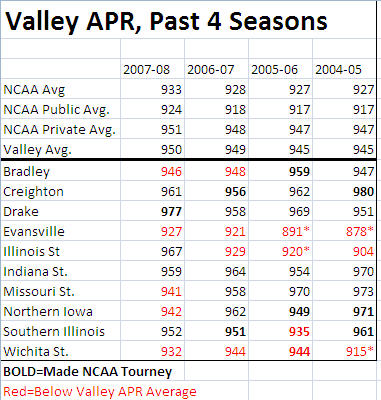Last week the NCAA released the APR (Academic Progress Rate) scores for all sports for all NCAA institutions. First a little background on the APR scores:
Back around 2002, the NCAA decided to start using an Academic Progress Rate score as a measurement in part for their Academic Reform. They said to sort of thing of the APR as an RPI score on the academic side of institutions. It is to help institutions to try and “right the ship” to get programs back on track.
They came up with a magic score of 925 as a standard of academic success for athletes. The APR is calculated by allocating points for eligibility and retention — the two factors that research identifies as the best indicators of graduation. Each player on a given roster earns a maximum of two points per term, one for being academically eligible and one for staying with the institution. A team’s APR is the total points of a team’s roster at a given time divided by the total points possible.Scoring below the 925 score can lead to penalties depending on how many years there are problems. If schools are not above that 925 (especially if you are under 900), here are the different penalties each consecutive year.
Teams with APR scores below 900 face additional sanctions under the historical penalty structure
- First-year sanction is a public warning letter for poor performance.
- Second-year sanctions include restrictions on scholarships and practice time.
- Third-year sanctions result in loss of postseason competition for the team (such as a bowl game or the men’s basketball tournament).
- Four consecutive years of poor academic performance results in restricted membership status for an institution. This means the school will not be considered a Division I college or university.
You may have heard about Centenary’s penalties being announced with the release of this year’s scores which appears to apply some of these rules. Now if you look at the 925 score, it still only indicates that you only graduated at least 50% of your athletes as indicated in an APR 101explanation of the process in a 2005 publication by the NCAA. .
To effect behavior in the desired cohort — teams with expected graduation rates below 50 percent — the committee had to pick the commensurate line in the APR. Ironically, committee members believe the APR number eventually will be a more understandable target than telling schools to graduate 50 percent of their players would have been.
“In three years, it’s my hope that people will understand an APR score without question,” Harrison said. “But since this is a new metric, we needed to equate it with something. We had to explain how we decided 925 was the right number. That adds confusion, though, because the words ‘graduation rate’ have a certain meaning, and the APR isn’t quite the same thing.”
So now that we understand APR scores a little more, as a case study, let’s take the Missouri Valley Conference basketball teams APR scores over the past 4 seasons of data. Do success of the teams have a relationship to APR scores? Are the APR scores any indication of where the teams are headed? Here is how the Valley breaks down:
In the chart, it breaks down each team and how they stack up against the NCAA average, public and private institutions and the Valley’s average. Now for the teams from the Valley that made the NCAA tournament over the previous 4 years (before this 08-09 season) their APR score was the highest when they went to the NCAA Tournament. For example, when Bradley went to the NCAA Tournament in 05-06 and made their sweet 16 run, their APR score was the highest of the four years. Wichita St. is the same. Creighton had the highest score of the seasons listed here and they made the NCAA Tournament that year. So you can sort of correlate that having players on a team that are also successful in the classroom can lead to success and an entry into the NCAA Tournament. As the scores have declined for some of these teams, the success has gone with it. However, coaching changes have also seemed to have an impact on things. Here is a brief breakdown of each Valley team:
Bradley–As mentioned above, Bradley had it’s best success when their APR was the highest of their 4 years. With Jim Les being the most tenured coach in the Valley behind Dana Altman, you would think he would be having more success than he has. But I think he has felt the pressure to bring in the same types of players he had in that 05-06 season and that has had an effect on APR scores the next two seasons falling below the Valley’s average APR score. With the APR slowly declining, there may be another reason why he might be on the “hot seat” next season.
Drake–Drake had it’s highest APR score last season when they had that dream year of winning the conference, conference tourney and being the only Valley team in the NCAA tournament. Having 3 different coaches in 3 years doesn’t appear to have hurt the academic success of the players brought into the program.
Evansville–The Purple Aces are a bit of a special case because the APR scores reported in 03-04 and 04-05 were based on Evansville having 3 or fewer players “on the team.” (denoted by the *) This is due to some FERPA rules that I don’t quite understand but I think if I understand correctly is that there are some student rights where they can choose not to have their academic data reported or who they are or something like that. Either way, Evansville has always been below the Valley average, but steadily improving as has their basketball team.
Illinois St.–It appears to me that Illinois St. not only wasn’t seeing success on the court but also the classroom in the Porter Moser era. Since Tim Jankovich came into Normal, the Redbirds APR has dramatically improved after being below the Valley average the 3 previous years.
Indiana St.–The Sycamores have been surprisingly consistent over the 4 reported seasons. Though they did not have success on the court, the previous coach before Coach McKenna recruited players that appeared to have academic success.
Missouri St.–Barry Hinson was a great guy…funny, short, and always had something to say. He was an advocate for the Valley. He probably got hosed a couple times that Missouri St. didn’t make the NCAA Tournament. However, you can tell from the chart that the things going for him didn’t translate to the classroom. The APR declined each year. So although the basketball team was somewhat successful and just missed the NCAA Tournament, the University was able to satisfy the fans calling for his head that they could use the student athlete excuse that he may not have been doing enough to help his players graduate.
Northern Iowa--The Panthers had great success getting to the NCAA Tourney a couple seasons in a row before Greg McDermott changed his Iowa zip code. Along with it and with Ben Jacobson now getting acclimated to going from an assistant to a head coach, it appears he was still trying to find the right mix of players that could play on the court and win in the classroom. The coaching change in this situation had an effect on the institution’s APR.
Southern Illinois–SIU is an interesting case because it really sticks out what a coaching change had a direct impact on the school APR. Between the 04-05 when Chris Lowery became head coach and 05-06 with his first set of recruits, the Saluki’s APR score fell a decent amount which pushed them under the Valley average, but is one case where they also made the NCAA tournament that year.
Wichita St.–It isn’t shocking that the Shockers have been below the Valley average. OK, maybe that isn’t fair to say. However, they haven’t been very impressive on the court or off the court in the classroom since their Sweet 16 run in 05-06. But once again, the replacing of a head coach had an impact as the APR dipped in 07-08 from 06-07 as Gregg Marshall started his first season. But I will give Marshall the benefit of the doubt because his history at Winthrop as he raised the APR of Winthrop from 926 to 952 and 962 in the three previous seasons before the first at Wichita.
Creighton–I saved Creighton for last. As Coach Altman has felt the pressure of taking the game to the next level and getting a different level of athlete on the team, has academic performance taken a hit because of it? I really don’t feel like that is the case. As I looked into things a little more, I get the feeling that the APR might have a bit of a flaw that might penalize teams for having JUCO (or non 4-year) players on the roster and having them finish their career here vs. having 4-5 year players spend their whole career at one school. Then you include the transfers, those get dinged too in most cases. The reason I say this is as I looked at the Jays roster from the 4 seasons here, I noticed something interesting:
- 04-05 season with 980 score–There were 7 players on the roster that were 4-5 year players meaning they spent their whole career here (Sitzmann, Funk, Hibma, McKinney, Motz, Tolliver and Watts) Quincy Henderson tranferred. 5 non 4-year guys (Day, Porter, Howard, Mathies, Milner)
- 05-06 season with 962 score–There were 7 players on the roster that were 4-5 year players which were the same as above, but replace Tyler McKinney with Josh Dotzler. Steve Smith and Dominic Bishop transferred. 7 non 4-year guys (Day, Porter, Bishop, Mathies, Gakou, Nengsu, Bahe)
- 06-07 season with 956 score–There were 6 players on the roster that were 4-5 year players (Sitzmann, Funk, Hibma, Tolliver, Watts and Dotzler). However look at all the transfers out–Issac Miles, D’Angelo Jackson, Ty Morrison, and Brice Nengsu. Then you had the suspension of Manny Gakou because of his playing days in France. 6 non 4-year guys (Porter, Millard, Morrison, Gakou, Nengsu, Bahe)
- 07-08 season with 961 score–There were 4 players (potentially 4 others) on the roster that were 4-5 year players (Sitzmann, Hibma, Dotzler, Watts) with the potential of 4 others (Stinnett, Korver, Lawson and Harriman) and but no transfers. 4 non 4-year guys (Witter, Millard, Woodfox, Bahe) Thus the slight score increase.
Now, in reality, I am probably pretty far off on this and I don’t have the knowledge enough of the other Valley teams (or the time) to see if this correlation works out across the board. It will be interesting to see how the scores from this past season (08-09) will eventually shake out. This past season there were 2 players (potentially 6 others) on the roster that were 4-5 year players (Dotzler, Sitzmann) with the potential of P’Allen Stinnett, Kaleb Korver, Josh Jones, Kenny Lawson, Casey Harriman, and Antoine Young being 4-5 year players and 4 non 4-year guys (Witter, Millard, Woodfox, Carter) Boy this is getting crazy now. So I expect the score to be about the same since you now have to also account for the transfers of Cavel Witter and Kenton Walker.
So, in the end, do the APR numbers really matter? I don’t know if they necessarily matter on the court. However coaching changes appear to take academic hits as well as trying to duplicate success after NCAA Tourney appearances. If the NCAA really wants to take a look at academic performance, I think they may need to take a look at these two situations to help coaches and players transition when coaching changes take place. After reading all of this, you probably want a part of your life back since this isn’t earth shattering. But it makes the whole APR thing a little more interesting..


